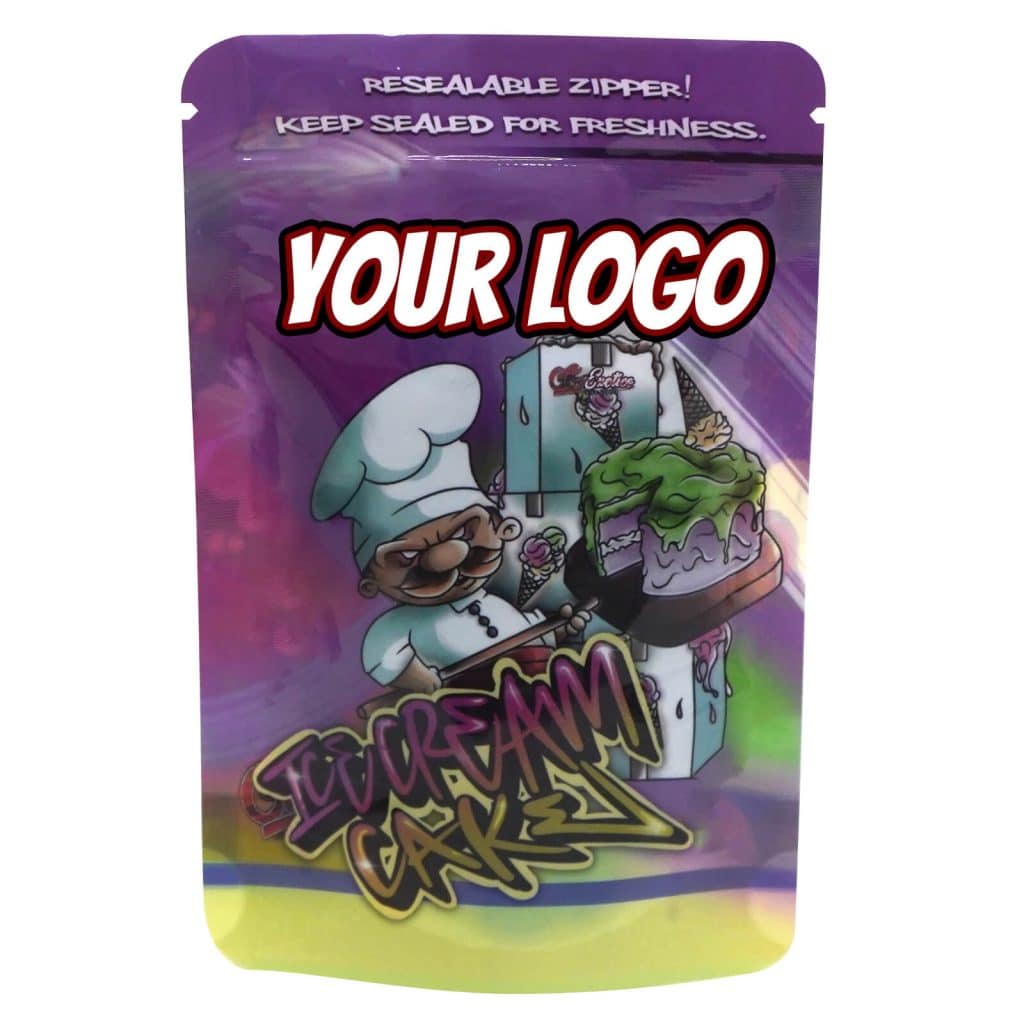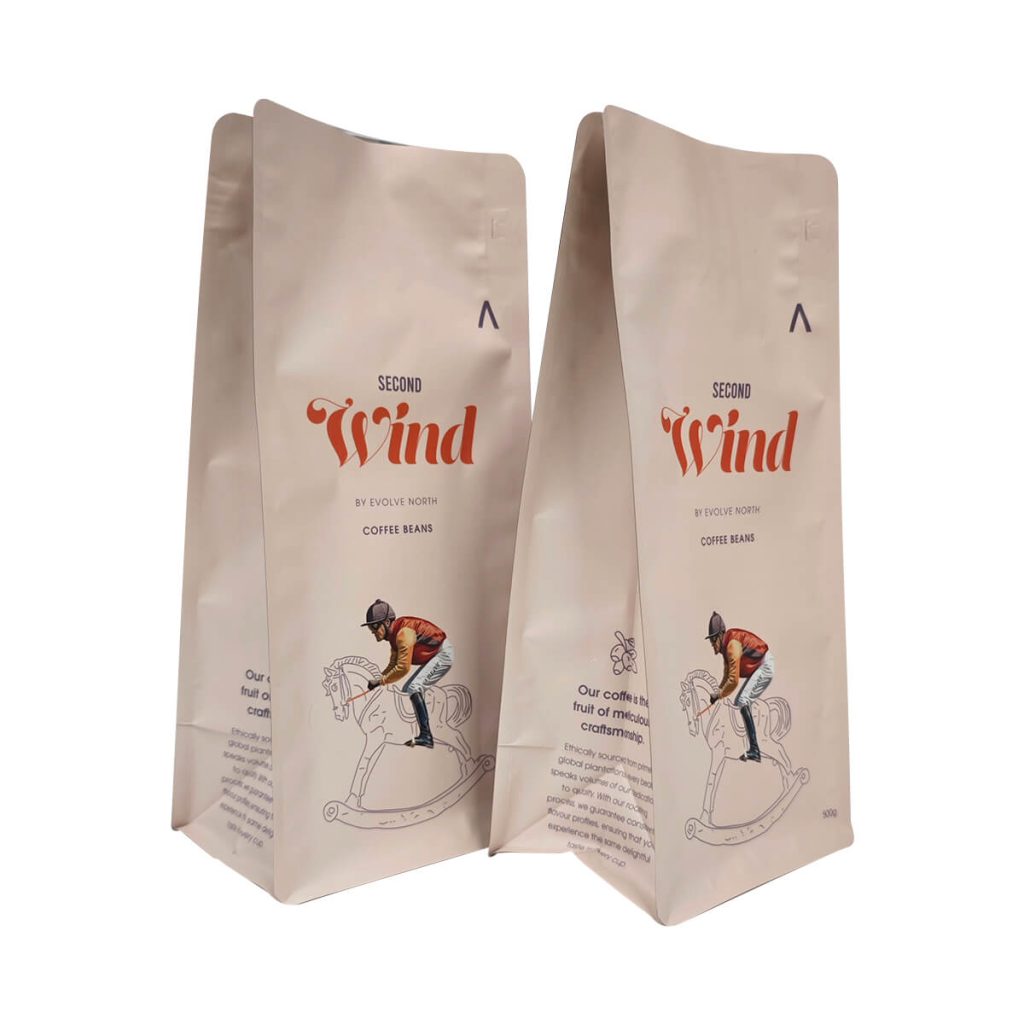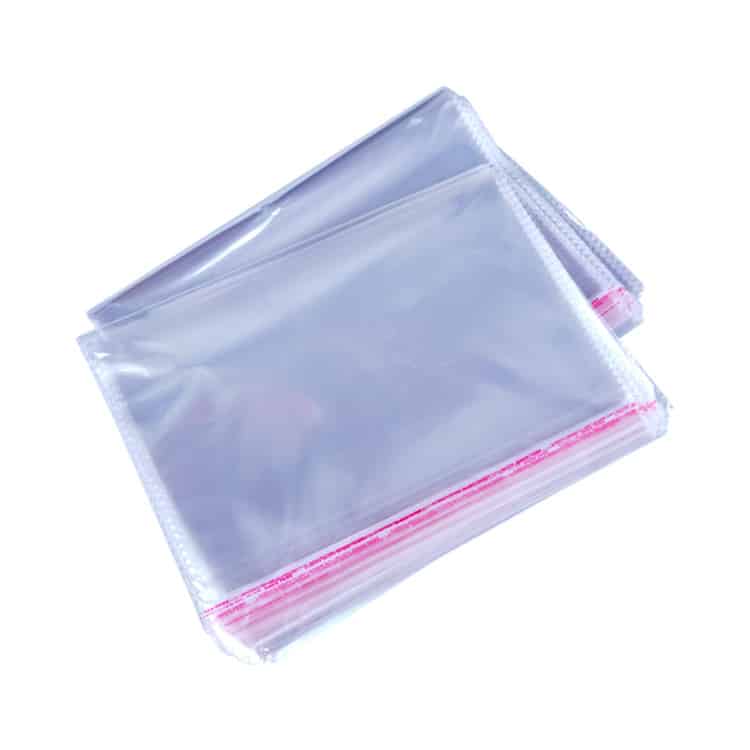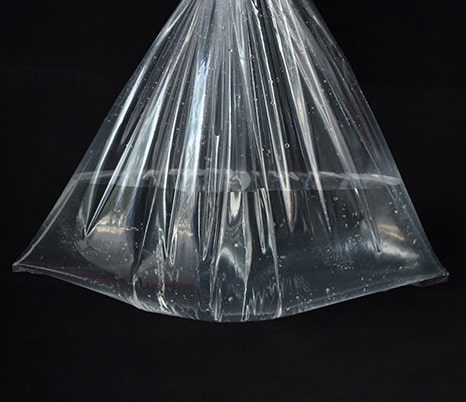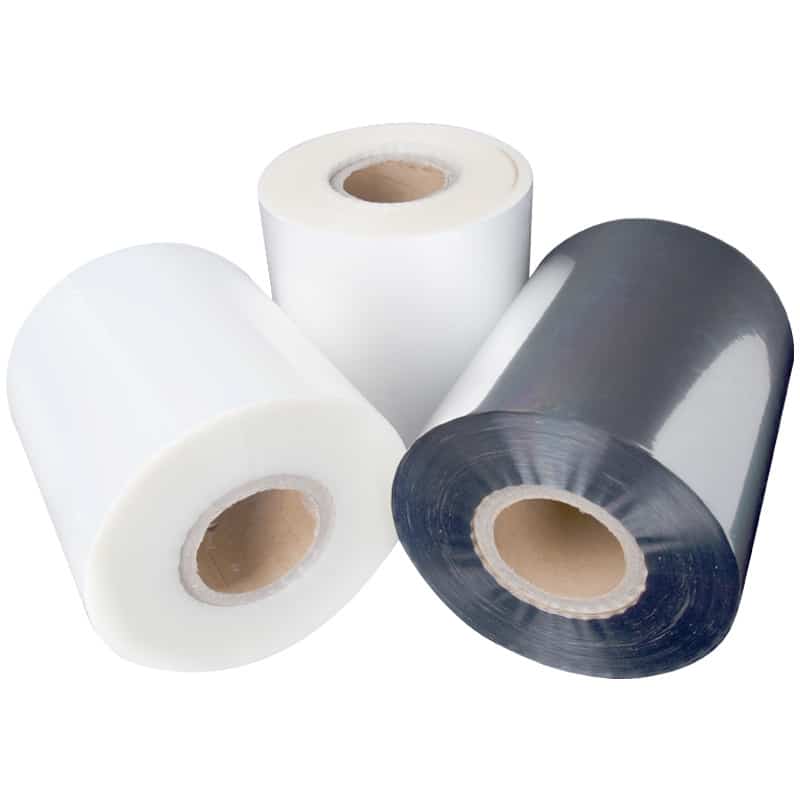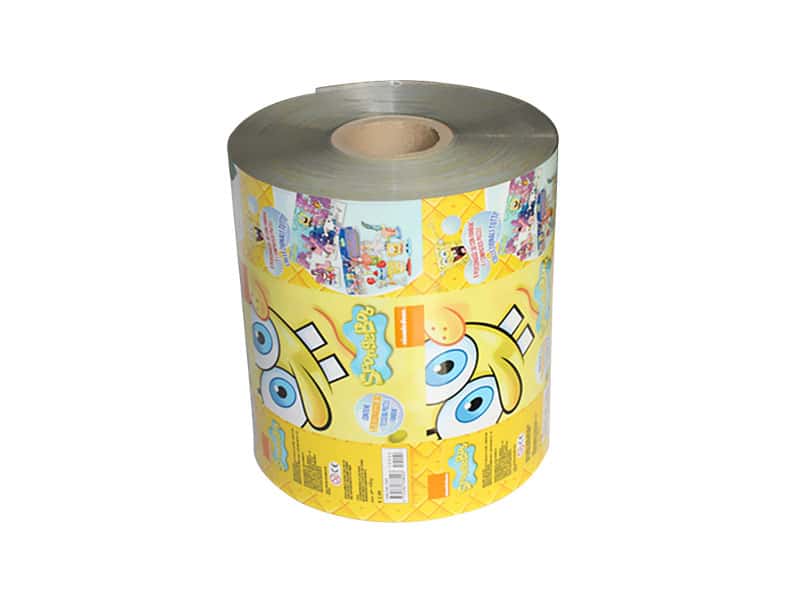Printing method for stand-up pouches
Printing on stand-up pouches can be challenging, but with the right equipment and techniques, it can be done successfully. Here is a detailed guide on how to print on stand-up pouches:
Pre-press preparation: Before starting the printing process, it is essential to prepare the artwork and ensure it is in the correct format. The artwork should be created in a vector-based program such as Illustrator or CorelDraw and saved as a print-ready PDF. The painting should also be the same size as the pouch and include any bleeds, trim marks, and die lines.
Printing equipment: There are several options for printing on stand-up pouches, including offset printing, digital printing, and screen printing. Offset printing is a traditional method that uses plates, inks, and rollers to transfer the image onto the pouch. Digital printing uses inkjet or laser technology to print directly onto the bag. Screen printing involves creating a stencil of the image and using a squeegee to push ink through the stencil onto the pouch.
Printing process: The printing process will vary depending on the chosen equipment, but some general steps are followed. First, the pouch material is loaded into the printing machine. The artwork is then transferred onto a plate or stencil, and the ink is applied to the vessel or stencil. The pouch is then fed through the printing machine, and the image is transferred onto the bag. After printing, the pocket may need to be dried or cured before it is ready to be used.
Finishing options: After printing, several finishing options can be applied to stand-up pouches. These include laminating the bag to add an extra layer of protection and to give it a glossy or matte finish. Pockets can also be foil stamped or embossed to add a metallic or raised effect to the image.
Quality control: It is essential to regularly check the quality of the printed pouches to ensure that the image is clear and there are no defects. This can be done by visually inspecting the bags and using quality control equipment such as densitometers and colorimeters.
Printing on stand-up pouches requires careful preparation, equipment, and attention to detail. Following these steps, you can produce high-quality printed bags that effectively showcase your brand and product.
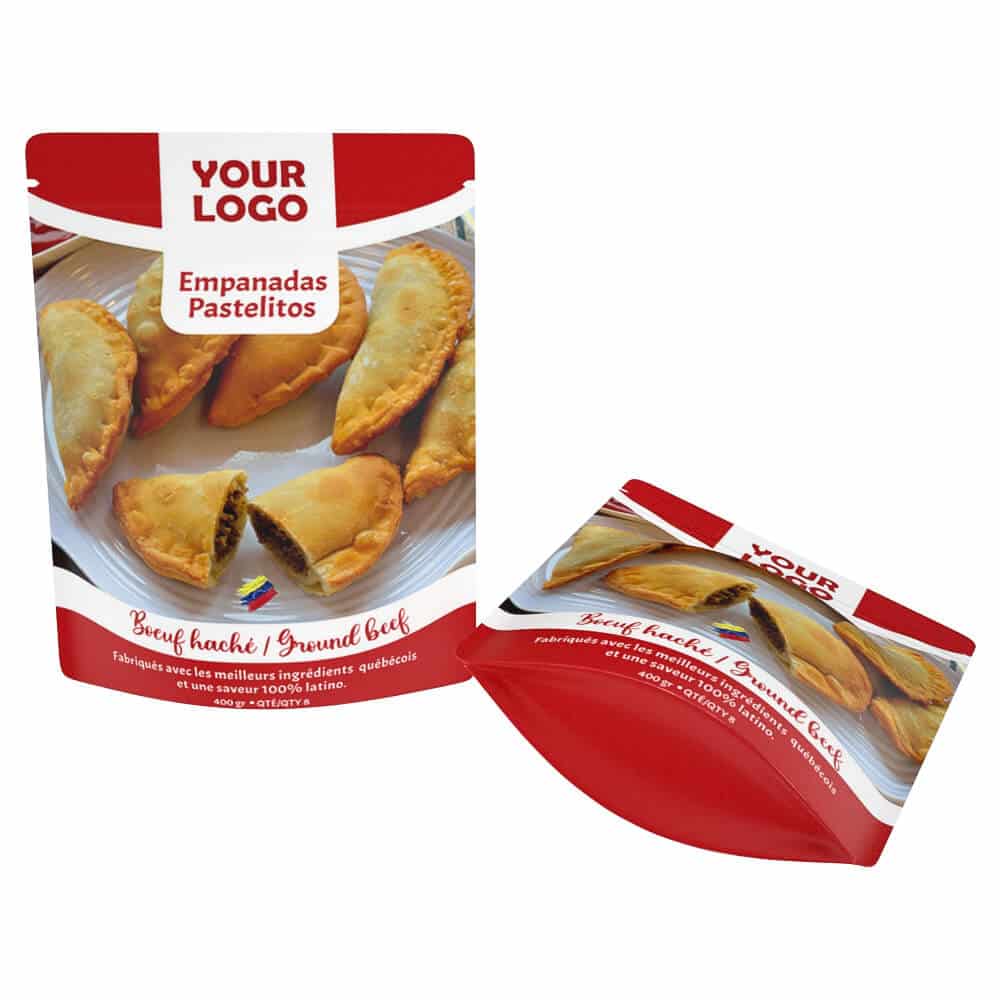
Gravure printing
Gravure printing is a plate-making technique in which the image is carved and concave from the surface, and the ink is filled directly into the concave pit of the gravure plate and then embossed onto the substrate.
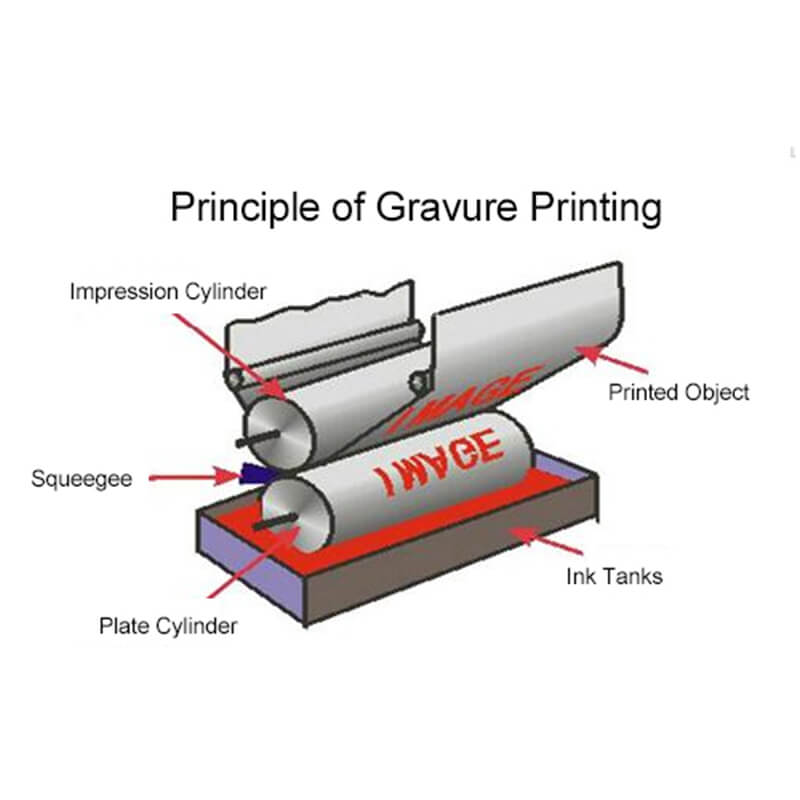
The Intaglio printing process is suitable for plastic film printing. Intaglio printing of plastic film after the ink layer is thick, the picture is rich in layers, the image is realistic, and has a rich sense of three-dimensionality. In contrast, intaglio printing requires the error of each color pattern.
At the same time, intaglio printing requires that the error of each color pattern be controlled within 0.3mm.
Gravure printing and surface printing process and printing process.
The so-called surface printing process is in the plastic film after printing, after bag making and other subsequent processes, so that the printed graphics presented on the surface; in the printing process is, the use of reversed-phase graphic printing plate, the ink will be published on the inside of the material.
Ink is printed to the inside of the material and then from the front of the performance, in the printing of the printing color sequence has specific requirements; the dark color in the show is generally black → cyan → magenta → yellow → white.
Gravure printing is mainly used for the printing of flexible packaging and is now widely used in self-standing bags for food,
Pharmaceutical industry bags have a wide range of substrates, such as paper plastic, high-grade tin foil wrapping paper, etc.
Advantages:.
- Ink expressiveness of about 90%, rich color tone. Strong color reproduction. Strong plate resistance. Printing quantity is grand
- Not easy to imitate and counterfeit, with strong anti-counterfeiting properties
Disadvantages:
- Expensive plate-making costs, printing costs are also expensive, plate-making work is more complex, and a small number of prints is unsuitable.
Flexographic printing
Flexographic printing uses a photosensitive resin plate (or rubber plate) as the plate material, glued to a variable repeat-length plate cylinder and inked by an anilox roller.
The anilox roller is controlled by another ink roller or squeegee to prevent ink delivery, mainly transferring liquid or fat ink to various printing materials. It can print up to 12 colors at a time.
Simple operation is a new development in the field of plastic printing methods. Flexographic printing still belongs to the category of letterpress printing.
However, its printing plate, ink, and embossing process differ from the traditional letterpress; the substrate has a wide range of adaptability, low printing costs, and good printing results.
They are widely used in various plastic bags, flexible packaging, composite packaging, stand-up pouches, etc.
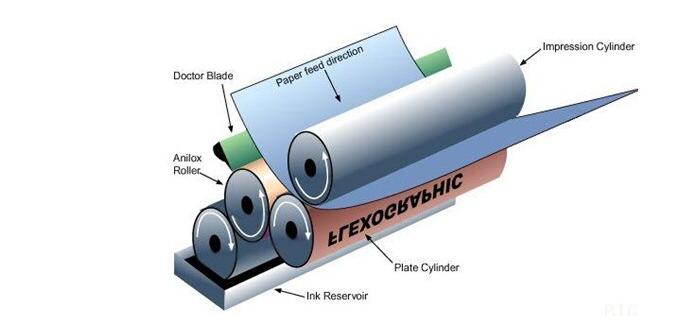
Flexo printing produces less noise, low cost, and low loss of plates and machinery.
However, flexo printing also has certain limitations. If the printing of small quantities of products is done, flexo printing costs less than gravure printing, and its ink and plate requirements will be higher, so the printing quality is compared to gravure.
Therefore, the quality of printing could be better than gravure printing.
Advantages:
- wide range of materials to be printed, printing ink, environmental protection, low cost of printing machine machinery, high quality of unique materials printing, in-line processing, and so on.
Disadvantages:
- Poor performance of color overlay prints, serious network expansion, unsuitability for printing, and high precision requirements of the images.
Screen Printing
Screen printing is mainly used to print plastic films and various molded containers. It can also print transfer materials for transferring graphics on specially shaped plastic containers.
Screen printing is done by squeezing a squeegee and transferring the ink through the screen.
Screen printing uses a screen perforated plate and printing material, and squeegee printing is used to obtain the graphics. Printing is done by injecting ink into one end of the screen printing plate, applying pressure to the inked area with a squeegee, and moving evenly towards the other end of the screen at the same time.
At the same time, towards the other end of the screen, moving evenly, the ink is squeezed from the mesh to the printed matter. The advantage of screen printing is that the screen can be attached to various shapes.
It is possible to print on curved surfaces, and it is also possible to mix various inks and paints, such as light-resistant pigments, into the ink.
For example, light-resistant pigments can be mixed into the ink, giving screen-printed products a significant advantage in light resistance.
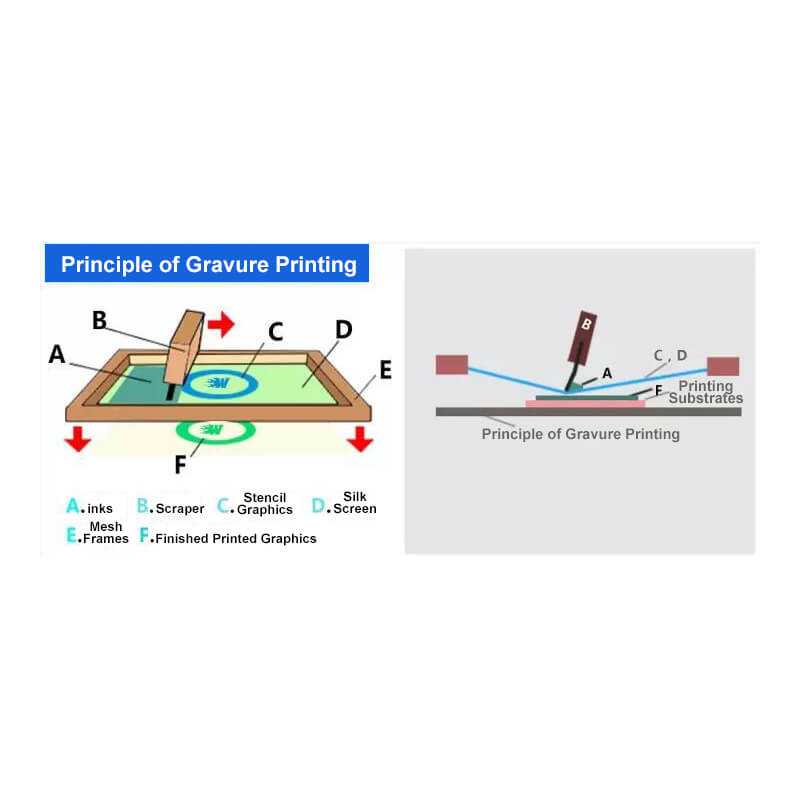
Screen printing is widely used because of its strong adaptability. Almost all screen printing uses clothes, shoes, electrical appliances, ceramics, glass, floor tiles, and other surface text decorations.
In the packaging field, screen printing is commonly used in high-grade boxes packaging bottles, like holiday gift boxes, cigarette boxes, wine boxes, etc., and can also be used for stand-up pouch packaging printing.
Advantages:
- flexible printing quantity, suitable for small orders, and needs their logo stand-up pouches for customers.
- Screen printing products have more decadent ink layers, bright colors, more robust coverage, a simple production process, less investment, and low cost.
- Unlike flexo printing, which has high ink and plate requirements, it is a cost-effective printing method.
Disadvantages:
- lower efficiency, lower printing accuracy, complex process
Digital printing
Digital printing is the electronic file from the computer directly to the printing machine, eliminating the traditional printing process of time-consuming and costly color separation, film output, imposition, ink preparation and calibration, and other links.
It brings printing into the most effective way: from input to output, the whole process is controlled by one person, realizing one sheet of printing, which is especially suitable for printing a small number of prints but many patterns.
We use digital printing from the United States Hewlett-Packard company-produced stand-up pouches digital printing machine!

Advantages:
- high printing quality, suitable for a small number of customized patterns of stand-up pouches
Disadvantages:
- digital printing is only suitable for printing small quantities, printing materials, a single type of printing needs, printing costs are higher than gravure printing
Printing bags to pay attention to what problems?
Printing bags to pay attention to what problems?
- There are different types of polyurethane ink; according to each class’s performance characteristics, the appropriate raw materials, such as polyurethane surface printing ink with water resistance, grease resistance, and liquid packaging, can not be selected from this type of ink.
- Printing should be strictly faithful to the original to ensure that the ink and water balance, ink color uniformity, dot full, and no printing faults, including scratches, scuffing, dirty, flower plate, paste plate, and so on;
- Ink color has a direct impact on the printing quality; if the ink color is terrible, it will directly affect the aesthetic and consumer, so printing must comply with the ink color standards to ensure that the printing effect;
- To ensure the printing quality of the liquid packaging film, printing should be printed on the printing tension, printing pressure, printing rate, and other process controls to maintain the stability of the printing process to ensure the quality of printing;
- The printing workshop environment will impact the function of the substrate and ink; if the climate is too dry, it will cause printing difficulties, so the printing environment should be reasonably controlled.
What is the definition of a stand-up bag? what are the advantages
A stand-up bag is a type of packaging designed to stand upright. These bags are typically made of flexible materials such as plastic or foil, and they have a gusseted bottom that allows them to expand and stand upright. Stand-up pouches are often used for various products, including food, personal care items, and household products.
One of the main advantages of stand-up bags is their convenience. Because they can stand upright on their own, they are easy to store and display on shelves or cabinets. This makes them a popular choice for retail products, as customers can easily see and access them.
Stand-up bags are also often used for products that need to remain fresh, as they can be sealed to keep out air and moisture. This makes them a good choice for perishable packaging items such as snacks, baked goods, and produce.
Another advantage of stand-up bags is their versatility. They can be made in various sizes and shapes to suit the needs of different products, and they can be customized with printing, labels, and other features to help promote a brand.
Stand-up bags are also relatively lightweight and easy to transport, which makes them a cost-effective choice for shipping and distribution. They are also often made from recycled materials, which makes them an environmentally friendly packaging option.
In addition to these benefits, stand-up bags are popular because they are easy to open and close. Many of these bags have a zipper closure or a tear-off top, which makes it easy to access the contents without tearing the bag. This is particularly useful for products intended to be consumed over time, as the bag can be resealed to keep the contents fresh.
Overall, stand-up bags are a practical and convenient packaging option widely used for various products. They are easy to store, transport, and display, and they can be customized to meet the needs of different products and brands.
Customizing a Stand-Up Bag
We are a professional stand-up pouch manufacturer that customizes all kinds of flexible packaging bags, including custom stand-up pouches, custom food packaging bags, custom zipper bags, and custom clear PE bags. , the following describes the customization process of our packaging bags.
Step 1. whether there is a color printing packaging bag design file. Sometimes companies have their packaging designers or looking for other design companies to do the design, then the design drawings to the packaging bag manufacturers; we will be color printing layout design.
If there are no design drawings, it is necessary to prepare a copy and provide us with the design. I must prepare the document; each industry-specific will be different but similar. Mainly includes must color printing information: name, logo, trademark, main ingredients (can be named after the formula, food formula), product registration bar code, net content, manufacturer information (including the manufacturer’s full name, license number, and address), product standard number, storage methods, methods of use, if there are allergens or should not be used, need to indicate the precautions, there is the size of the bag specifications, want to The use of bag type and material, the direction of the bag roll film out of the mark, the commonly used theme color, the company’s cultural overview, the widely used background image and the theme you want to reflect. This copy information must be carefully checked in detail; there must be no typos. Then our designer will design the design, and then the designed drawing will be handed over to you for confirmation, and the information above will be checked carefully again. There may be a few round trips between the design and check confirmation, and the time is sometimes different. If there is no problem, then proceed to the next step.
Step 2. packaging bags’ color printing plate version; our soft package engineers will be based on the design drawings, materials and process requirements, printing layout, and printing plate production. This intermediate takes about 5~6 days.
Step 3. printing and composite slitting production. The selected bag material for color printing, the color printing speed of different equipment is different, and the printing effect is also different, including high-speed machine color printing efficiency is the highest after completing color printing for other processes, such as aluminum washing, hot stamping, surface lamination, etc. Let after is the heat seal layer and further increase the performance of the film layer of the composite; after the completion of the composite need to dry curing. After the lamination is completed, the lamination is tested, and the wrong places are marked. Then slitting and rewinding, the bag color printing production is complete. Directly supply good packaging roll film quality inspection to fully automatic packaging manufacturers.
Step 4. the color printing packaging bag making. Slitting and rewinding good color printing roll film, put on the corresponding bag-making machine for automatic bag making. A zipper bag-making machine can produce stand-up pouches with zipper, eight-side seal bags, and other bags. Some bag types need to be folded before the bag-making device.
Step 5. quality inspection packaging, the unqualified products out, and strive to achieve zero unable products factory, the qualified outcomes for packaging, some will use cartons for packaging, some will use nylon bags for packaging.
The sixth step, delivery acceptance, usually will use freight logistics delivery, and if more urgent, will also use the expressway. The beautifully printed color printing bags are sent to the customer for acceptance.
What are the ways of bag printing?
There are several methods of printing on bags, each with its advantages and disadvantages. Here is a summary of some of the most common ways:
- Screen Printing
Screen printing is a popular method of printing on bags due to its low cost and versatility. It involves creating a design stencil, which is then applied to a screen made of porous material. Ink is then pushed through the screen onto the bag using a squeegee. This method is suitable for printing simple designs on many packs.
2. Heat Transfer Printing
Heat transfer printing involves printing the design onto a special paper using inkjet or laser. The printed transfer paper is then placed onto the bag and heated using a heat press or iron. The heat activates the ink on the transfer paper, causing it to bond with the pack’s fabric. This method is suitable for printing complex designs and is relatively easy to do at home.
3. Digital Printing
Digital printing is a relatively new method of printing on bags that uses inkjet or laser printing technology. It involves printing the design directly onto the bag using a digital printer. This method is suitable for printing high-quality, full-color designs and is particularly well-suited for publishing small quantities of bags.
4. Embroidery
Embroidery is a method of decorating bags using needles and thread. The design is sewn onto the bag using a particular embroidery machine. This method is suitable for printing detailed, high-quality designs and is particularly well-suited for printing logos or text.
5. Offset Printing
Offset printing is a method of Printing that involves transferring the design from a printing plate to a rubber blanket and then onto the bag. This method is suitable for printing large quantities of bags and is particularly well-suited for publishing high-quality, full-color designs.
6. Dye Sublimation Printing
Dye sublimation printing is a method of Printing that involves printing the design onto special transfer paper using a dye sublimation printer. The transfer paper is then placed onto the bag, and heat is applied, causing the ink on the form to vaporize and bond with the fabric of the pack. This method is suitable for printing high-quality, full-color designs and is particularly well-suited for printing polyester bags.
Summary
As a professional stand-up pouch manufacturer, we provide stand-up pouch custom production, including logo, color, and size can be customized. We provide various customized services for customers to have their bag brand.

